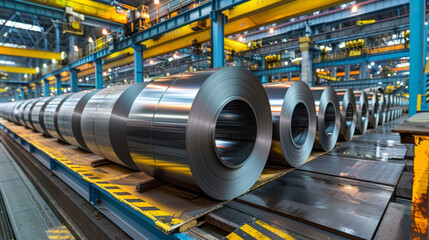Artificial Intelligence (AI) has emerged as a transformative force across various industries, and the steel industry is no exception. The integration of AI into steel production processes is not just a trend but a necessity for staying competitive in an increasingly digital and data-driven world. This article explores how AI is being implemented in the steel industry, its impact on efficiency, cost reduction, and sustainability, and the future potential it holds.
The Steel Industry’s Need for Innovation
The steel industry, a cornerstone of global industrial infrastructure, has long been associated with traditional manufacturing processes. These processes, while effective, are often energy-intensive, resource-heavy, and prone to inefficiencies. As global markets demand higher quality steel at lower costs, the industry faces mounting pressure to innovate. This is where AI comes into play. By leveraging AI, steel manufacturers can optimize production processes, enhance quality control, reduce energy consumption, and ultimately lower operational costs.
You must be Read: The Future of AI in the Automotive Industry: Safety, Efficiency, and Personalization
AI-Driven Process Optimization
One of the most significant applications of AI in the steel industry is in process optimization. AI algorithms, particularly those involving machine learning, can analyze vast amounts of data generated during steel production. This data includes temperature readings, chemical compositions, pressure levels, and other critical parameters. By processing this data in real-time, AI systems can predict the optimal conditions for various stages of steel production, such as melting, casting, and rolling.
For instance, AI can optimize the blast furnace operation by predicting the precise amount of raw materials needed, thus minimizing waste and reducing energy consumption. Moreover, AI-driven models can adjust the furnace temperature and pressure in real-time, ensuring that the steel produced meets the desired quality standards while maximizing efficiency.
Enhancing Quality Control with AI
Quality control is paramount in the steel industry, where even minor deviations can result in significant losses. Traditional quality control methods often involve manual inspections, which are time-consuming and subject to human error. AI, however, offers a more precise and efficient solution.
AI-powered computer vision systems can inspect steel products at various stages of production with incredible accuracy. These systems can detect surface defects, such as cracks, scratches, or deformations, that might be invisible to the human eye. By identifying these defects early in the production process, AI helps prevent defective products from reaching the market, thereby reducing waste and enhancing customer satisfaction.
Furthermore, AI can analyze patterns in production data to predict potential defects before they occur. This predictive capability allows manufacturers to make proactive adjustments, reducing the likelihood of defects and improving overall product quality.
Reducing Energy Consumption and Environmental Impact
The steel industry is one of the largest consumers of energy and a significant contributor to global greenhouse gas emissions. As environmental regulations become stricter and the push for sustainable practices intensifies, the industry must find ways to reduce its carbon footprint. AI plays a crucial role in achieving this goal.
By optimizing production processes, AI can significantly reduce energy consumption in steel manufacturing. For example, AI algorithms can determine the most energy-efficient operating conditions for machinery, minimizing unnecessary energy use. Additionally, AI can optimize the scheduling of production activities to ensure that energy-intensive processes are performed during periods of lower energy demand, thus reducing overall energy costs.
AI also contributes to sustainability by improving material efficiency. Through precise control and monitoring, AI systems can reduce the amount of raw materials needed for production, thereby conserving natural resources and reducing waste. This not only lowers operational costs but also aligns with the global push towards more sustainable industrial practices.
Cost Reduction Through AI Integration
Cost reduction is a primary driver for the adoption of AI in the steel industry. By enhancing process efficiency, reducing waste, and improving product quality, AI directly contributes to lowering production costs. However, the benefits of AI extend beyond operational efficiency.
AI can also optimize supply chain management in the steel industry. By analyzing market trends, demand forecasts, and supplier performance data, AI systems can make informed decisions about inventory levels, procurement strategies, and logistics planning. This leads to more efficient supply chain operations, reduced inventory costs, and improved profitability.
Moreover, AI-driven predictive maintenance systems can minimize equipment downtime, a significant cost factor in the steel industry. These systems use data from sensors installed on machinery to predict when maintenance is needed, allowing for timely interventions that prevent costly breakdowns and extend the lifespan of equipment.
The Future of AI in the Steel Industry
The integration of AI in the steel industry is still in its early stages, but the potential for future developments is immense. As AI technologies continue to advance, their applications in steel production are expected to expand and evolve.
One area of potential growth is in the development of AI-driven autonomous production systems. These systems could operate with minimal human intervention, using AI to make real-time decisions about production parameters, quality control, and maintenance. This would not only increase efficiency but also allow for more flexible and responsive production processes, capable of adapting to changing market demands.
Another promising development is the use of AI in conjunction with other emerging technologies, such as the Internet of Things (IoT) and Big Data analytics. By integrating AI with IoT devices, steel manufacturers can create smart factories where data from connected devices is used to optimize every aspect of production. This could lead to unprecedented levels of efficiency, quality, and sustainability in steel manufacturing.
Furthermore, AI could play a key role in the development of new steel materials. By analyzing data from experiments and simulations, AI systems could help discover new alloys with improved properties, such as greater strength, durability, or corrosion resistance. This would open up new possibilities for the use of steel in various industries, from construction to automotive manufacturing.
Challenges and Considerations in AI Adoption
Despite its potential, the adoption of AI in the steel industry is not without challenges. One of the primary concerns is the high initial investment required for AI implementation. Integrating AI systems into existing production processes often involves significant costs related to technology acquisition, infrastructure upgrades, and employee training. However, these costs are typically offset by the long-term benefits of improved efficiency and cost savings.
Another challenge is the need for skilled personnel to manage and operate AI systems. The steel industry, traditionally dominated by mechanical and chemical engineers, must now attract and retain talent with expertise in AI, data science, and machine learning. This requires a shift in workforce development and training strategies to ensure that employees have the necessary skills to work alongside AI technologies.
Data security is also a critical consideration. As AI systems rely on vast amounts of data, ensuring the security and privacy of this data is paramount. Cybersecurity measures must be in place to protect sensitive production data from potential breaches or cyberattacks.
Finally, there is the challenge of integrating AI with existing legacy systems. Many steel plants operate with equipment and processes that have been in place for decades. Retrofitting these systems with AI technology can be complex and requires careful planning to avoid disruptions in production.
Conclusion
The steel industry is at a crossroads, where traditional manufacturing practices must evolve to meet the demands of a rapidly changing world. AI offers a powerful solution to the industry’s challenges, from optimizing production processes to enhancing quality control and reducing environmental impact. While the adoption of AI comes with its challenges, the long-term benefits of increased efficiency, cost savings, and sustainability make it a worthwhile investment.
As AI technology continues to advance, its role in the steel industry is likely to grow, driving further innovations and setting new standards for production and efficiency. Steel manufacturers that embrace AI today will be better positioned to thrive in the competitive landscape of tomorrow, delivering high-quality products while minimizing costs and environmental impact. The future of the steel industry is smart, efficient, and AI-driven, and those who harness the power of AI will lead the way into this new era of manufacturing.
FAQs
1. What is the role of AI in the steel industry?
AI plays a transformative role in the steel industry by optimizing production processes, enhancing quality control, reducing energy consumption, and lowering operational costs. By analyzing vast amounts of data in real-time, AI helps manufacturers make precise adjustments to improve efficiency and product quality.
2. How does AI improve process efficiency in steel production?
AI improves process efficiency by analyzing data from various stages of steel production, such as melting, casting, and rolling. It predicts optimal conditions, adjusts operations in real-time, and minimizes waste, leading to more efficient and cost-effective production.
3. Can AI help in reducing the environmental impact of steel manufacturing?
Yes, AI contributes to sustainability by optimizing energy use and reducing waste in steel manufacturing. By identifying the most energy-efficient operating conditions and improving material efficiency, AI helps the industry reduce its carbon footprint and conserve natural resources.
4. How does AI enhance quality control in the steel industry?
AI enhances quality control through advanced computer vision systems that detect defects in steel products with high accuracy. It also analyzes production data to predict potential issues before they occur, ensuring that only high-quality products reach the market.
5. What are the cost benefits of integrating AI into steel production?
The integration of AI into steel production reduces costs by improving process efficiency, reducing waste, and enhancing product quality. Additionally, AI optimizes supply chain management and predictive maintenance, leading to lower inventory and maintenance costs.
6. What challenges does the steel industry face in adopting AI?
The adoption of AI in the steel industry faces challenges such as high initial investment, the need for skilled personnel, data security concerns, and the integration of AI with existing legacy systems. However, these challenges can be managed with careful planning and investment in workforce development.
7. What is the future potential of AI in the steel industry?
The future potential of AI in the steel industry includes the development of autonomous production systems, integration with IoT for smart factories, and the discovery of new steel materials. As AI technology advances, its applications in the industry are expected to expand, driving further innovation and efficiency.
8. How does AI optimize supply chain management in the steel industry?
AI optimizes supply chain management by analyzing market trends, demand forecasts, and supplier performance. This allows steel manufacturers to make informed decisions about inventory levels, procurement strategies, and logistics, resulting in more efficient operations and reduced costs.
9. Is AI adoption in the steel industry widespread?
AI adoption in the steel industry is still in its early stages but is rapidly growing. As more companies recognize the benefits of AI in improving efficiency, reducing costs, and enhancing sustainability, the adoption rate is expected to increase significantly in the coming years.
10. What are some examples of AI applications in steel manufacturing?
Examples of AI applications in steel manufacturing include process optimization, quality control, energy management, predictive maintenance, and supply chain optimization. These AI-driven solutions help steel manufacturers improve their operations and stay competitive in a global market.













